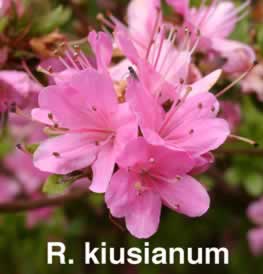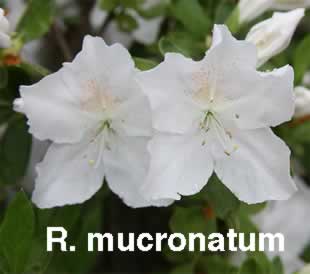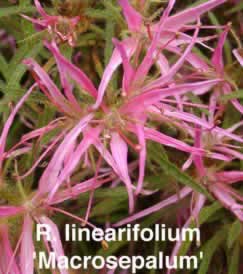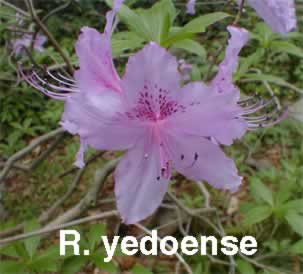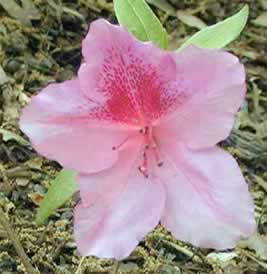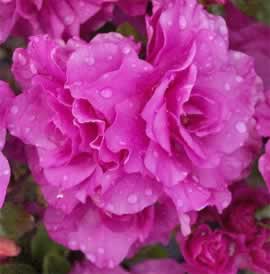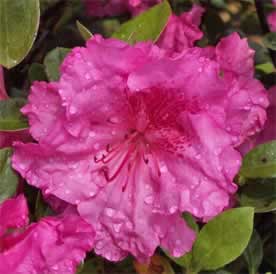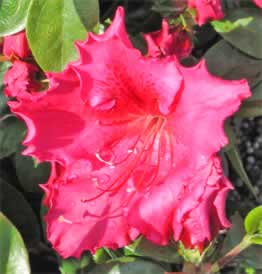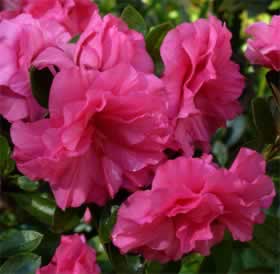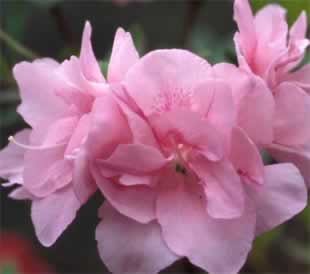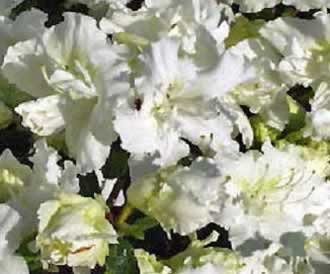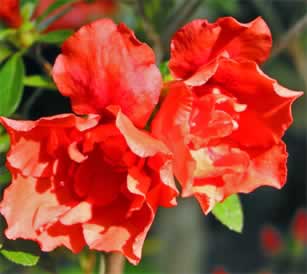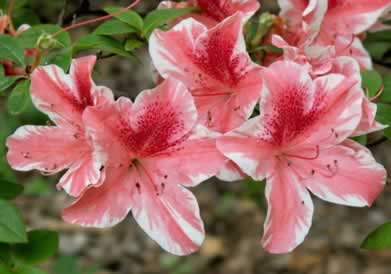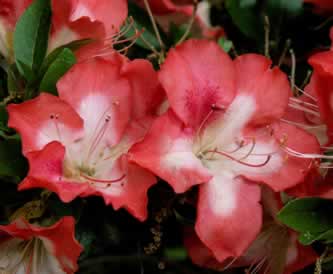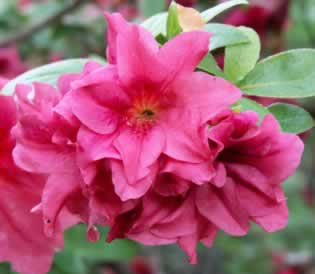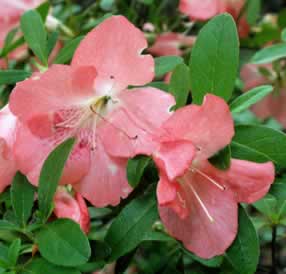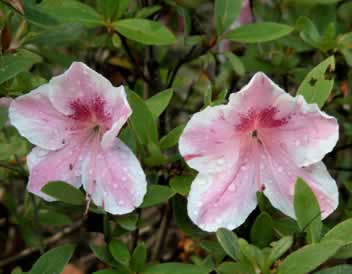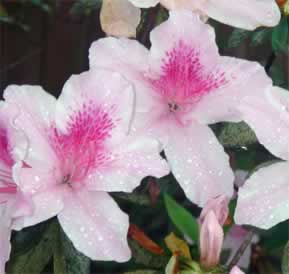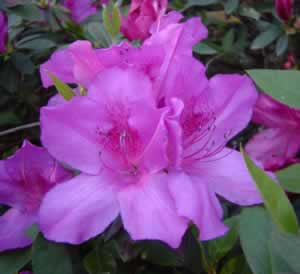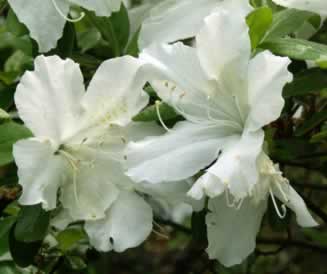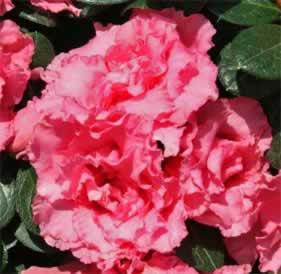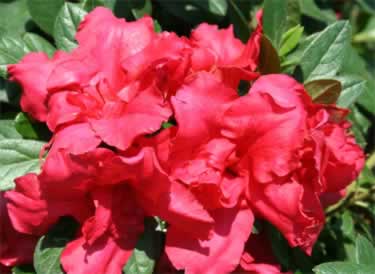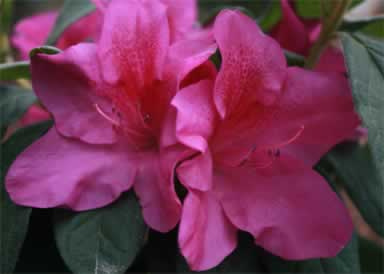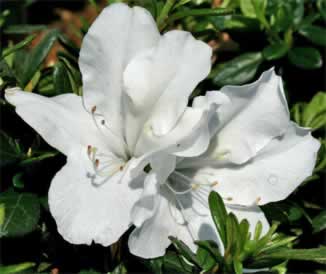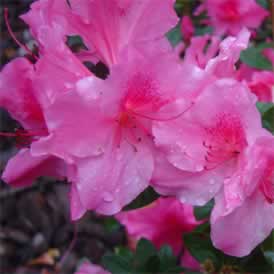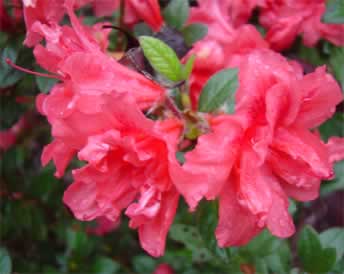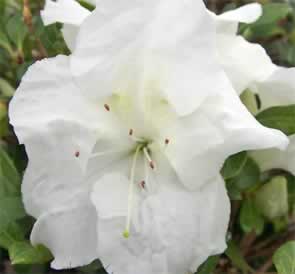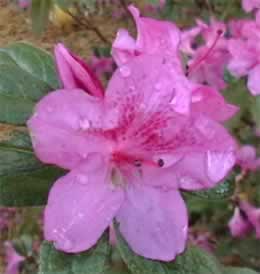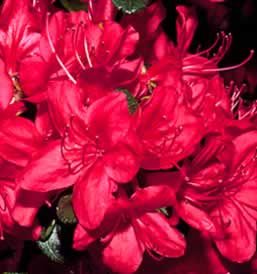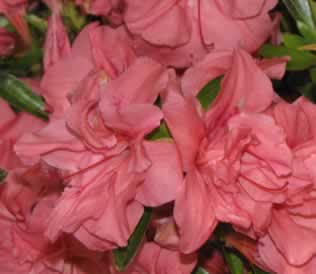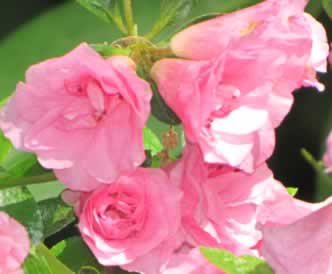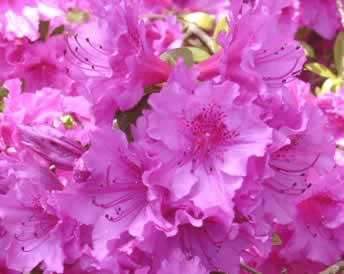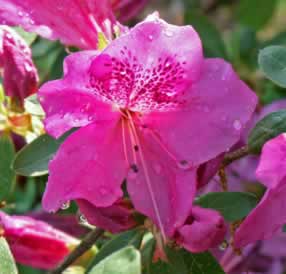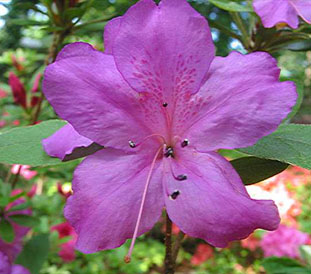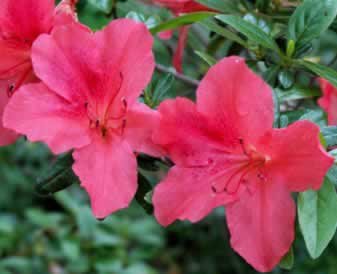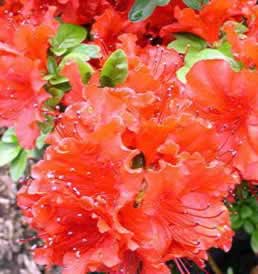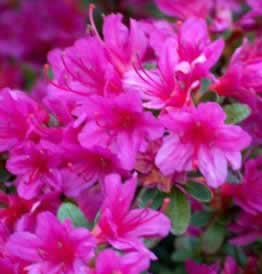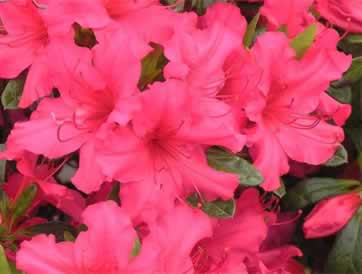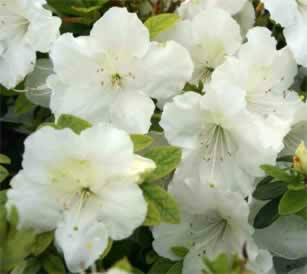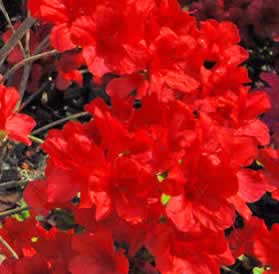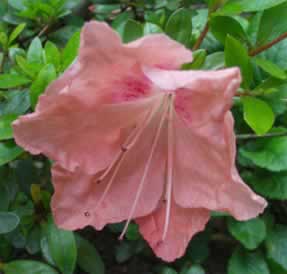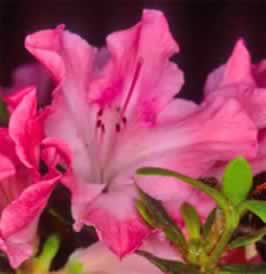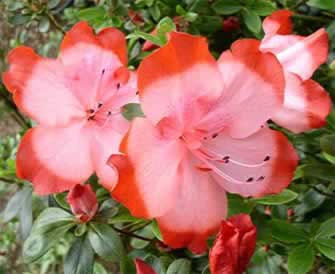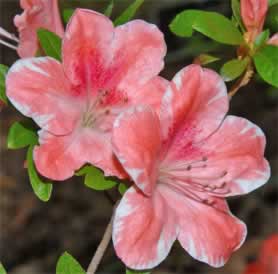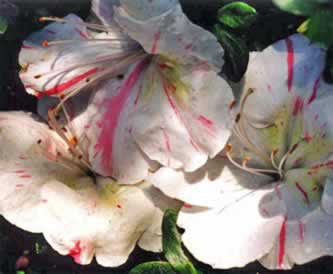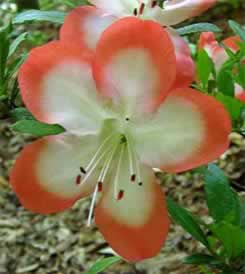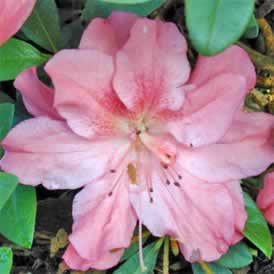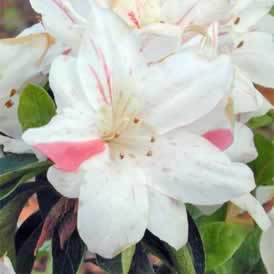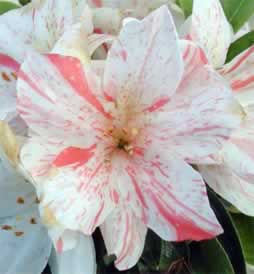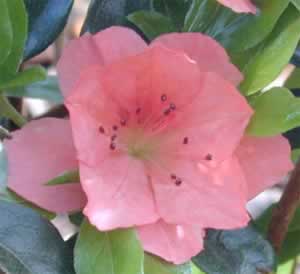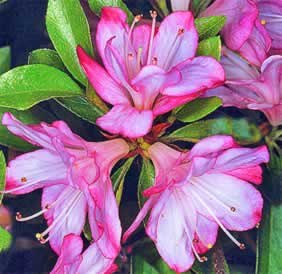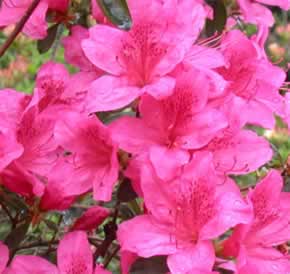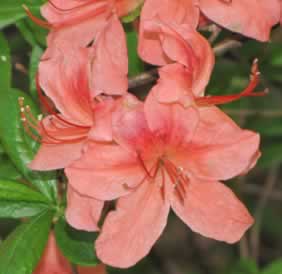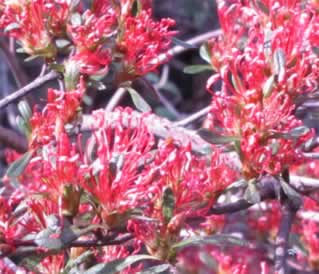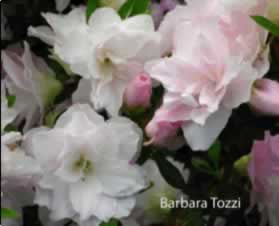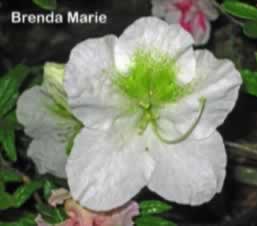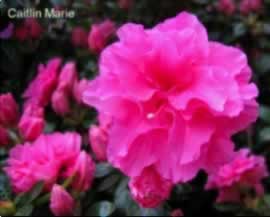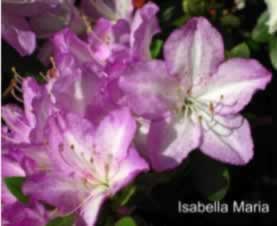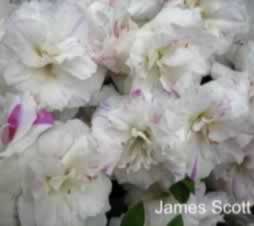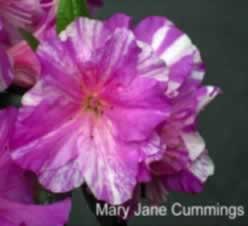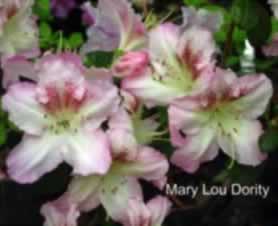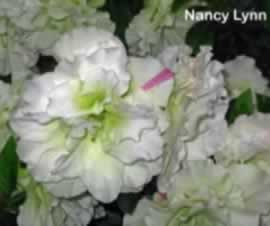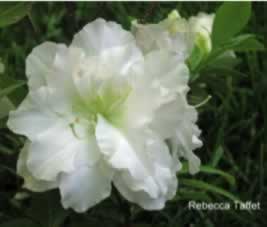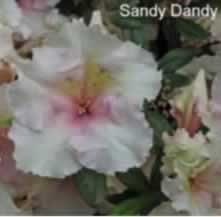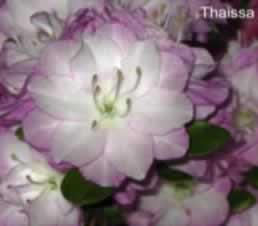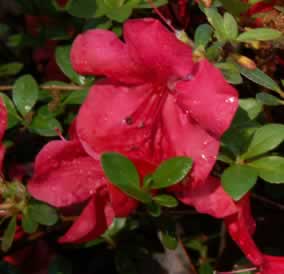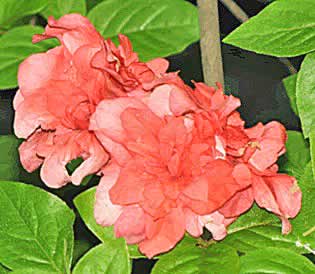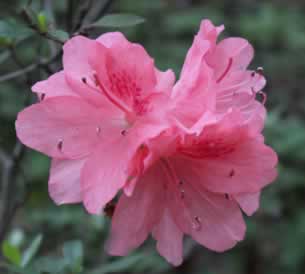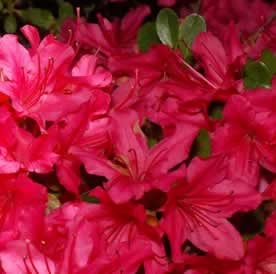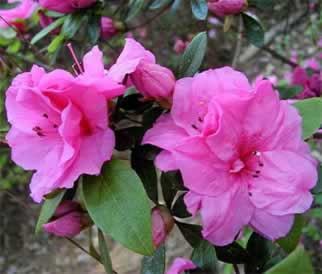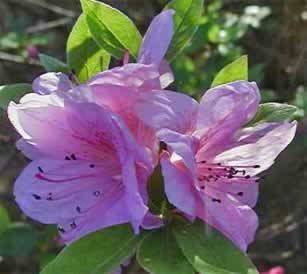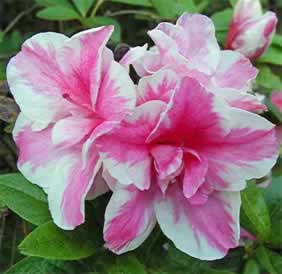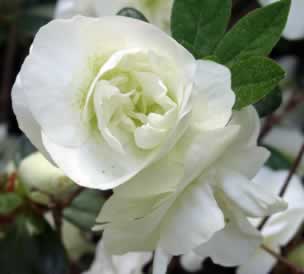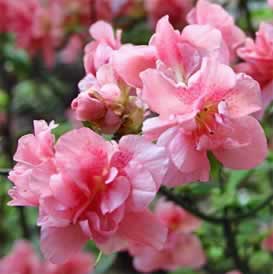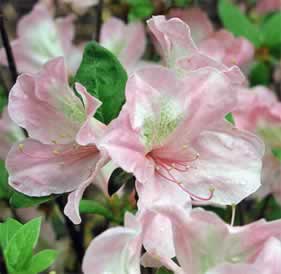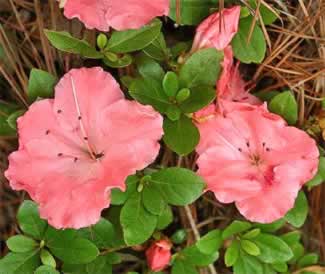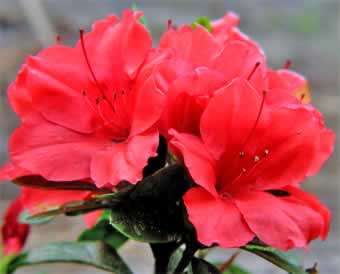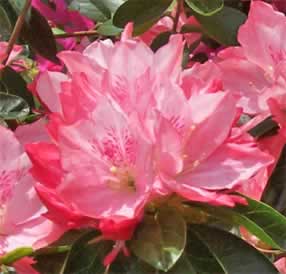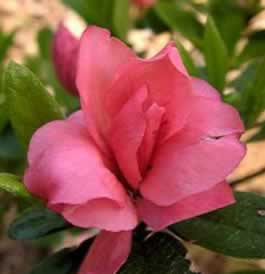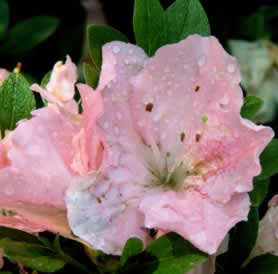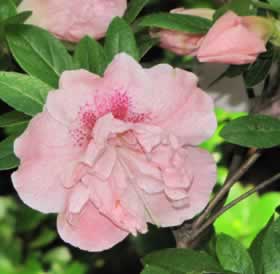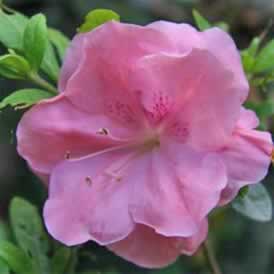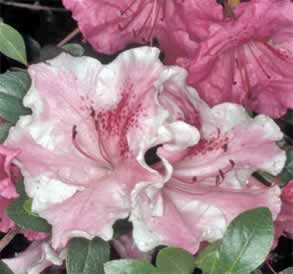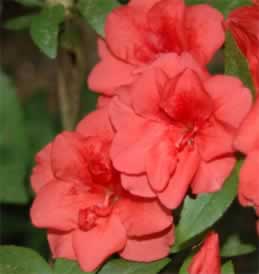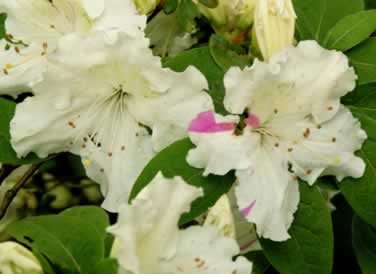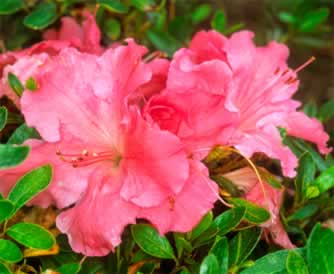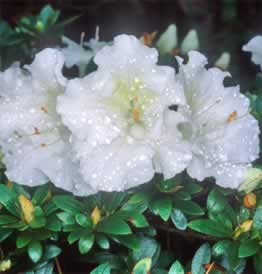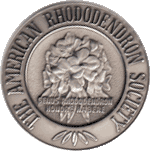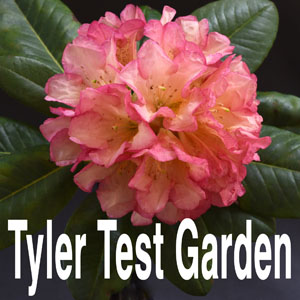
Evergreen Azaleas
The most impressive flowering shrub in the Northeast and the Northwest is the rhododendron, and the most stunning flowering shrub of the Southeast, Gulf Coast and Southern California is the evergreen azalea (neither survives in the central U.S.). Azaleas, including evergreen azaleas, are members of the rhododendron genus. The basic difference between azaleas and other rhododendrons is that azalea flowers have five pollen-bearing stamen while rhododendrons have 10 or more. The exceptions are R. canadense and R. vaseyi which have from 7 to 10 stamen. Azaleas are among the most colorful of all flowering shrubs, bearing 3- to 6-inch clusters of red, yellow, orange, pink, white or purple flowers in spring and early summer, and in many cases providing brilliantly hued leaves in fall. Evergreen azaleas are widely grown from Zone 6 south. Many nursery catalogues list azaleas separately from the related plants commonly called rhododendrons, but both belong to a single genus, Rhododendron. Azaleas will serve most garden uses admirably, and they also can be grown in open woodlands in light shade where, with proper initial soil preparation, they are often able to take care of themselves indefinitely.
All evergreen azalea species are in the subgenus Azaleastrum and are native to Asia. Species of Tsutsusi (evergreen azaleas) occur only in southeastern Asia. They are most numerous in Japan, with some species in southeastern China, Korea, the Philippines and in Taiwan. Many appear to be evergreen because they are dimorphic, that is they grow two sets of leaves each year. Dimorphic evergreen azaleas have spring leaves and summer leaves. The spring leaves unfold at the beginning of the growing season and are dropped in autumn. Summer leaves emerge in early summer and are smaller, thicker, darker, and more leathery than spring leaves. They remain on the plant during the dormant period and drop in the spring, however, summer leaves may persist for several years in warm climates and may drop before spring in cold climates. The latter is called being semievergreen or semipersistent.
Evergreen azaleas began to be established in Europe in the early 1800's. The first ones were not hardy and were used for greenhouse and indoor decoration, and are know as Indian or Belgian Indian Hybrids. The name "Indian" was derived from a misidentification of Rhododendron indicum as being associated with this group. A mixed group developed in the southern US beginning in the middle of the 1800's, in part from the Belgian Indian types, is known as Southern Indian Hybrids. A large group of evergreen azaleas, known as Kurume Hybrids, has its origin near the Japanese city of Kurume. They became widely known in the West through the work and writing of E.H. Wilson, who selected and imported 50 cultivars from Japan, arriving at Arnold Arboretum in Boston 1919. The new summer blooming Encore Azaleas are related to the Kurume azaleas. A third major group is the Kaempferi Azaleas, derived in part from Rhododendron kaempferi and developed in Holland after World War I. Another group, the Satsuki Azaleas, is highly prized in Japan and has been used by hybridizers in the West.
The Inter-Group Evergreen Azalea Hybrids include relatively new groups of hybrid azaleas that have been derived from plants in several groups, such as Satsuki, Kaempferi, and Kurume. The popular Glenn Dale hybrids are assigned to this group; they were developed, starting in 1935, by B.Y. Morrison in Glenn Dale, Maryland. Back Acre hybrids were also developed by B. Y. Morrison after his retirement to Pass Christian, Mississippi, in 1964, where he continued his azalea breeding work on his farm called Back Acres. Robin Hill hybrids were developed in New Jersey, so they are cold hardy. Dr. August Kehr, former geneticist with the U.S. Department of Agriculture, developed some spectacular azalea cultivars having double or semi-double camellia-like flowers. Gable hybrids were introduced by the late Joseph B. Gable, a nurseryman and hybridizer in Stewartstown, Pennsylvania. They are among the hardiest evergreen azaleas. Linwood Hardy hybrids were developed by Al Reid by combining outstanding characteristics of greenhouse plants with the hardy azaleas. Pennington hybrids consist of 16 named cultivars developed by the late Ralph Pennington in Covington, Georgia. Harris hybrids were developed by James Harris in Lawrenceville, Georgia. Pericat hybrids were developed by Alphonse Pericat in Collingdale, Pennsylvania for greenhouse forcing but are as hardy as Kurume hybrids. Aromi hybrids were developed by Dr. Gene Aromi, a retired University of Southern Alabama professor in Mobile, Alabama. Holly Springs hybrids were created by Col. Ronald C. Vines (Ret.) in Springfield, Virginia just south of Washington DC. Col. Huang hybrids were created by a Mr. Huang in China. Klimavicz hybrids were created by Joe Klimavicz in Vienna, VA.
Most of the rhododendrons and azaleas grown in gardens are hybrids, and their ability to resist cold differs remarkably from one variety to another. For this reason it is best to purchase rhododendrons and azaleas from a local nurseryman who grows his own plants. The descriptions below cover evergreen azaleas that have proven satisfactory in fairly broad regions.
[Return to Top]
Examples of Evergreen Azalea Species
Evergreen Azalea Species
R. kiusianum, the Kyushu azalea – 4', -10F. It is a low-growing Japanese species, only 18 inches high. Its leaves are deciduous when the plant is young but evergreen in maturity, remaining on the plant all winter, though often changing color. In its original form the Kyushu azalea is covered in mid-spring with 8- to 10-inch clusters of lilac pink flowers, but there are many named hybrids derived from this species bearing white, pink, rose or purple flowers. It blooms while still young, bearing flowers 1 to 1 1/2 inches across. It is hardy in Zone 7, +5° F. This semi-evergreen spreading shrub grows 3 feet tall, but up to 5 feet wide. The shiny 1-inch leaves sometimes turn red in winter.
R. mucronatum, the Snow azalea – 3', -5F. It has Chinese ancestry but is not found in the wild. It is commonly used for ornamental pruning, grows 6 feet high and 4 to 6 feet wide. It is hardy to Zone 5, -15 F. Its many branches are densely covered with oval evergreen leaves, 1 1/2 to 2 1/2 inches long, matted with hairs. Its fragrant white flowers, 1 to 3 inches wide, often bloom in pairs and may be stained with green, lilac or pink at the base, depending on the variety.
R. stenopetalum 'linearifolium' – 4', -15F. The Spider azalea, is an unusual Japanese species. It is a 4-foot-tall shrub with narrow, ribbon-like evergreen leaves, 3 inches long and 1/2 inch wide, and rose-pink flowers with deeply divided petals. It is hardy to Zone 5, -15° F. In one variety, R. linearifolium 'Macrosepalum', the plant is somewhat smaller, 3 feet tall, and the leaves are deciduous and 3 inches long. But the flowers are even more curiously shaped than those of the species; they have 1 1/4-inch-long sepals that overshadow the petals. The flowers of this variety are fragrant and have been bred in several colors; in one, 'Polypetalum', flower petals and leaves are so similar in size that the plant seems to have pink and green leaves.
R. yedoense, the Yodogawa azalea – 2', -5F. It has 2-inch double reddish purple flowers in late spring. Although this plant is technically an evergreen azalea it is deciduous in cold climates. Plants rarely grow more than 3 feet tall, but may spread to 6 feet in diameter. It is hardy in Zone 6 to -5° F. The variety R. yedoense 'Poukhanense', Korean Yodogawa azalea, has single flowers and is a bit more resistant to winter cold than the double-flowered type. It is a low, spreading plant that is hardy to -15° F. The leaves of both drop in Northern gardens, but remain nearly evergreen in milder climates. [Return to Evergreen Azalea Species Index]
[Return to Top]
Examples of Hybrid Evergreen Azaleas
These are the major groups of hybrid evergreen azaleas:
- Aromi Azaleas (Gene Aromi, Mobile, AL)
- August Kehr Hybrids (Auggie Kehr, MD & NC)
- Back Acres Azaleas (Ben Morrison, Pass Christian, MS)
- Belgian Indian Azaleas (Belgium)
- Bloom-A-Thon® Azaleas (Robert & Lisa Head, Seneca, SC)
- Encore Azaleas (Buddy Lee, Independence, LA)
- Gable Azaleas (Joe Gable, Stewartstown, PA)
- Girard Azaleas (Peter Girard, Geneva, OH)
- Glenn Dale Azaleas (Ben Morrison, Glenn Dale, MD)
- Harris hybrids (James Harris, Lawrenceville, GA)
- Holly Springs (Pete Vines, Springfield, VA)
- Huang (Huang, China)
- Indica Azaleas or Indian Azaleas (Belgium)
- Kaempferi Azaleas (Holland)
- Kehr Hybrids (Auggie Kehr, MD & NC)
- Klimavicz Hybrids (Joe Klimavicz, Vienna, VA)
- Kurume Azaleas (Kurume, Japan)
- Linwood Hardy hybrids (Al Reid, Linwood, NJ)
- Pennington hybrids (Ralph Pennington, Covington, GA)
- Pericat hybrids (Alphonse Pericat, Collingdale, PA)
- Robin Hill (Robert Gartrell, NJ)
- Satsuki Azaleas (Japan)
- Southern Indian Azaleas (Southern US)
[Return to Top]
Aromi Azaleas by Dr. Gene Aromi of Mobile, AL
The Aromi hybrids were developed by Dr. Gene Aromi, a retired University of Southern Alabama professor, and his wife Jane, a retired elementary school teacher in Mobile, Alabama. They began their hybridizing program in 1969 to develop evergreen azaleas with "large flower size, early bloom time, improved bud hardiness, compact habit, and array of flower forms, and rich colors". They have named 31 evergreen azalea hybrids. [Return to Hybrid Evergreen Azalea Index]
August Kehr Hybrids from MD and NC
August Kehr Hybrids. Dr. August Kehr, former geneticist with the U.S. Department of Agriculture, developed some spectacular azalea cultivars having double or semi-double camellia-like flowers. Cultivars include ´Anna Kehr´, double rosy-pink flowers with wavy edges; ´Mary Lou Kehr´, light pink, semi-double fragrant flowers; ´Great Expectations´, reddish-orange double flowers; and ´White Rosebud´, white double flowers with yellow-green center. The plants are hardy to 0 degrees F. [Return to Hybrid Evergreen Azalea Index]
Back Acre Azaleas by Ben Morrison, Pass Christian, MS
Back Acres azaleas were also developed by B. Y. Morrison after his retirement to Pass Christian, Mississippi, in 1964, where he continued his azalea breeding work on his farm called Back Acres. They are hardy to Zone 7, +0° F and may grow upright or spread out; they usually reach 3 to 5 feet in height after about seven years. Individual blossoms range from 1 1/2 to 3 inches across. Of the 50 named varieties the following are recommended: ´Marian Lee´, (white petals with a tint of pink and carmen-red border); ´May Blaine´, (light purple double flowers); and ´Debonair´, (vivid pink flowers with deep pink edges and light pink to greenish centers). For hardiness: 'Aphrodite', purplish pink; 'Ben Morrison', salmon-pink; and 'Fashion', rose pink, are hardy to Zone 6, -5° F. [Return to Hybrid Evergreen Azalea Index]
Indica or Belgian Indian Azaleas
|
George Lindley Tabor, Indica |
|
Delaware Valley White, Indica |
The Indica or Belgian Indian azaleas are divided into two groups according to their hardiness. The Belgian Indicas were developed as house plants in the 1800s and are generally hardy to Zone 10, +35° F; Southern Indicas were developed from plants at Magnolia Plantation in Charleston, S.C. and are generally hardy to Zone 8, +15° F. Both types may become 6 feet tall and 10 feet or more across after 5 to 10 years in the garden. The flowers, especially of the Belgian Indica type, are apt to be frilled at the edge or many-petaled double blossoms and often are 2 to 3 inches across. Typical Belgian Indica varieties are: 'Alaska', snow white, two layers of petals; 'Albert and Elizabeth', white, edged pink, double; 'Avenir', salmon pink, double; 'California Sunset', variegated white and pink, double; and 'Fire Dance', fiery red, double. Typical Southern Indicas, all with single blossoms having one layer of petals, are 'Brilliant', red; 'Duc de Rohan', salmon pink; 'Fielder's White', snow white; 'Prince of Wales', cherry red; ´Formosa´, (deep magenta-purple flowers); ´George Lindley Tabor´, (white flowers with purplish-pink blotch and purple throat); ´Delaware Valley White´, (pure white flowers with ruffled petals); and 'Southern Charm', deep rose pink. For hardiness: 'Formosa', also called 'Phoenicia', lavender, is hardy to Zone 6, -5° F. [Return to Hybrid Evergreen Azalea Index]
Bloom-A-Thon® Azaleas are similar to Encore™ azaleas and are said to bloom for 4-6 weeks in spring, and then another 12-16 weeks in summer and fall. Introduced in Spring 2012, little is known about them. They are patented as are Encore™ azaleas and the Bloom-A-Thon patents compare them to Encore™ azaleas. Bloom-A-Thon® Pink Double is double and the pollen parent is 'Watchet'. Bloom-A-Thon® red is semi-double and the pollen parent is 'September Song'. Bloom-A-Thon® Lavender is single. Bloom-A-Thon® White is single and the pollen parent is 'September Song'. They are all said to be hardy in USDA zones 6-9. [Return to Hybrid Evergreen Azalea Index]
Encore Azaleas by Buddy Lee, Independence, LA
Encore Azaleas™ are similar to Kurume azaleas except they are bred to both bloom in the spring on old growth and then bloom again in the summer and fall on new growth. Encore azaleas™ were introduced by Robert E. "Buddy" Lee, in Independence, Louisiana. They are bred from Rhododendron oldhamii ´Forth of July´ -- a cultivar selected from seed collected in 1968 at 2,500 feet up Taiwan's Mount Tai Tun. The female parent used to create Autumn Amethyst™ was a winter hardy hybrid called ´Karens,´ a cross between ´Hinodegiri´, the old Kurume variety, and R. yedoensis var. poukhanense, the Korean azalea. Lee selected the seedling that was to be named Autumn Amethyst™, 'Conlee', in 1986 but did not receive the plant patent until 1998. Encore azaleas™ are available in an array of colors, growth forms and bloom characteristics. One of the newest cultivars is Autumn Angel™, 'Robleg', the first white flowered fall blooming azalea. Common varieties include Autumn Royalty™, 'Conlec'; Autumn Rouge™, 'Conlea' and Autumn Cheer™, 'Conlef'. There are currently more than 20 varieties. They have primarily been tested in the Southeast US. The hardiest ones are good to Zone 7, +5° F and include: Autumn Amethyst™, 'Conlee'; Autumn Angel™, 'Robleg'; Autumn Belle™, 'Robleo'; Autumn Carnation™, 'Roblec'; Autumn Carnival™, 'Conlet'; Autumn Chiffon™, 'Robled'; Autumn Coral™, 'Conled'; Autumn Debutante™, 'Roblel'; Autumn Embers™, 'Conleb'; Autumn Empress™, 'Conles'; Autumn Monarch™, 'Conleo'; Autumn Moonlight™, 'Robler'; Autumn Princess™, 'Roblea'; Autumn Rouge™, 'Conlea'; Autumn Royalty™, 'Conlec'; Autumn Ruby™, 'Conler'; Autumn Sangria™, 'Roblee'; Autumn Starlite™, 'Roblem'; Autumn Sundance™, 'Roblef'; Autumn Sunset™, 'Roblen'; Autumn Sweetheart™, 'Robleja; and Autumn Twist™, 'Conlep'. [Return to Hybrid Evergreen Azalea Index]
Gable Azaleas by Joe Gable, Stewartstown, OH
Gable azaleas from Joe Gable in Pennsylvania are hardy to Zone 7, -5° F. The plants, most of which become 2 to 4 feet tall in four to six years and have 1-inch shiny leaves, bear great numbers of 2-inch blossoms in the spring. Typical varieties are 'David Gable', rosy pink; 'Forest Fire', blood red; 'Louise Gable', salmon pink; 'Rosebud', bright pink; 'Rose Greeley', white; and 'Stewartsonian', deep red. For hardiness: 'Herbert', purplish red; 'Purple Splendor', rich purple; and 'Stewartsonian', blood orange; are hardy to Zone 5, -15° F. [Return to Hybrid Evergreen Azalea Index]
Glenn Dale Azaleas by Ben Morrison, Glenn Dale, MD
Glenn Dale azaleas from Ben Morrison at the U.S. Department of Agriculture Plant Introduction Station in Glenn Dale, Maryland, are hardy to Zone 7, +0° F and may grow upright or spread out; they usually reach 3 to 5 feet in height after about seven years. Individual blossoms range from 1 1/2 to 3 inches across. Of the 450 named varieties the following are recommended: 'Aphrodite', pale rose pink; 'Buccaneer', orange red; 'Cavalier', orange red; 'Everest', white with chartreuse blotch; 'Geisha', white striped red; 'Glacier', white; ´Zulu´, (vivid purple flowers with dark blotch); ´Cinderella´, (white and red flowers or white stripped with red); ´Ambrosia´, (deep yellow-pink flowers); ´Sagittarius´ (vivid pink flowers with orange undertones); and 'Vestal', white with chartreuse blotch. For hardiness: 'Aphrodite', purplish pink; and 'Fashion', rose pink, are hardy to Zone 6, -5° F. [Return to Hybrid Evergreen Azalea Index]
Girard Azaleas by Peter Girard in Geneva, Ohio
|
Girard's Hot Shot, Girard |
|
Girard's Sandra Ann, Girard |
|
Girard's Pleasant White, Girard |
Girard azaleas are a fairly recent introduction among evergreen azaleas suitable for colder climates. Their growth habits vary with variety, but generally most are fairly low and bushy. Leaves are bright green and some develop a reddish fall color. Although some older leaves may drop in the fall, leaf retention is greater than that of the Gable hybrids. Flowers are primarily single, but fairly large. There are many fairly hardy varieties in this group. Here are a few distinctive varieties to consider.
- Girard's Hot Shot – 2', -15F. Large flowers in a deep orange-red to scarlet. Plants develop an orange-red leaf color in the fall for winter color.
- Girard's Sandra Ann – 3', -10F. Large purple ruffled flowers make this a distinctive variety. Plants are more upright than some Girard varieties.
- Girard's Rose – 3', -10F. Large wavy rose-colored flowers are produced on somewhat upright plants. This is a very hardy variety with leaves that turn reddish in winter.
- Girard's Pleasant White – 3', -15F. Flowers are white with a cream center. Although the single flowers of this variety are smaller than many, they are prolific. Plants are hardy and one of the last to bloom. [Return to Hybrid Evergreen Azalea Index]
Harris Azaleas by James Harris of Lawrenceville, GA
Harris hybrids were developed by James Harris in Lawrenceville, Georgia. Several cultivars have large vivid-red flowers with light-colored centers and dark margins. Some have a cascading growth habit and are excellent for hanging basket culture. Most bloom mid-season. ´Bryan Harris´, pink with a light center, is one of the popular cultivars. Others include ´Fascination´, single pinkish-white flowers with deep-red borders; ´Parfait´, pastel pink flowers with red dots; and ´Midnight Flare™, single, deep red flowers with wavy edges. [Return to Hybrid Evergreen Azalea Index]
Holly Springs Azaleas by Col. Ronald C. Vines of Springfield, VA
|
Ron Vines Jr., Holly Springs |
The Holly Springs hybrids were created by Col. Ronald C. Vines (Ret.) in Springfield, Virginia just south of Washington DC. Col. Vines ("Pete") started his hybridizing program in 1977 "to produce azaleas with larger blooms, dwarf to mid-size growth habit and increased cold hardiness". [Return to Hybrid Evergreen Azalea Index]
Huang Azaleas by Mr. Huang of China
The Huang hybrids were created by Mr. Huang in China before their Cultural Revolution. Col. Vines ("Pete") feels the Huang hybrids may be the most important hybrid groups of evergreen azaleas in existence, in terms of the diverse bloom size and type, foliage and plant habit within the group. All cultivars were introduced without names, using a four digit numerical code (2-1-62 as an example).
- 1-2-2011 blooms in early April with a medium size flower.
- 1-3-62A bloom in early April with a small flower.
- 2-5-1971 blooms in late April with a medium hose-in-hose flower.
- 3-6-1961 blooms in mid May with a small hose-in-hose flower. [Return to Hybrid Evergreen Azalea Index]
Kaempferi Azaleas
|
Roehr's Peggy Ann, Kaempferi |
Kaempferi azaleas which originated in Holland are hardy to Zone 6, -5° F. Graceful plants that become 5 to 6 feet tall after about five years, they bear many 2-inch flowers in spring. Toward the northern edges of their areas they lose some leaves in cold winters. Typical varieties are 'Barbara', deep pink; 'Fedora', deep pink; 'Holland', deep red; 'Mikado', bright red; 'Othello', orange red; 'Thais', crimson; 'Wilhelmina Vuyk', white; and 'Zampa', violet red. [Return to Hybrid Evergreen Azalea Index]
Klimavicz Azaleas
|
Isabella Maria, Klimavicz |
Joe Klimavicz has been hybridizing since 1989 in Zone 7. With azaleas from Bob Stewart and Pete Vines, Joe moved to his 1/3-acre lot in Vienna, VA. He makes about 10 crosses each year, and brings out of his basement close to 1000 new azaleas each year. The Klimavicz hybridization program is aimed at developing a plant that is vigorous, and disease and insect resistant, with a flower that is unusual and long lasting. He has registered 15 azaleas to date. His registered azaleas are described below.
- Barbara Tozzi - EM 2" SD Pink, light, Pink flecks, very nice; Tall plant, dark green [Nancy Dippel x Florence Waldman].
- Brenda Marie - M 3" S White, huge green blotch, great; Medium plant [CB-1 x (Elsie Lee x Dancing Butterfly)].
- Caitlin Marie - M 2" D Pink, ruffled, very double, very floiferous; Medium plant, hardy, great foliage [Elsie Lee x Satellite].
- Gloria Louis - EM 2" S Purple w/White center, blotch, very nice; Medium plant [Carol Kittel x Girard Fuchsia].
- Isabella Maria - M 2" S Lavender, White center, very nice; Medium plant [Carol Kittel x Girard Fuchsia]. [Return to Hybrid Evergreen Azalea Index]
More Klimavicz Azaleas
|
Mary Jane Cummings, Klimavicz |
|
Mary Lou Dority, Klimavicz |
More Klimavicz Hybrids
- James Scott - M 2" SD White w/Purple stripes, great; Medium plant [Mary E. Thomsen x Florence Waldman].
- Lovely Linda -EM 2" H Pink, light, lighter center; Medium plant, great foliage [Florence Waldman x Dayspring].
- Mary Jane Cummings - EM 2 " S White w/tremendous Purple stripes/sectors; Medium plant [Brenda Marie x (Festive x Satellite)].
- Mary Lou Dority - M 2.5" S White w/Pink edges, large Red blotch; Medium plant, very nice [Betty Christopher x Komo Kulshan].
- Nancy Lynn - M 2" D Pale Lavender, Yellow cast, ruffled, nice; Tall plant [Nancy Dippel x Florence Waldman]. [Return to Klimavicz Evergreen Azaleas]
More Klimavicz Azaleas
|
Rebecca Tafflet, Klimavicz |
|
Spirit of Valdosta, Klimavicz |
|
Zoe Elizabeth Stoltz, Klimavicz |
More Klimavicz Hybrids
- Rebecca Tafflet -LM 3" D White, very ruffled; Med plant, great dark foliage [Elsie Lee x Satellite] .
- Sandy Dandy - EM 2" S Yellow White, light Pink base of tube, very ruffled, very floriforous; Med plant [Leopold Astrid x Girard Fuchsia].
- Spirit of Valdosta - M 2" S Bright Pink, Black V in blotch; Med plant, dark green [Elsie Lee x Gay Paree].
- Thaissa - M 1.5" SD White center w/Purple wash, no blotch; Med plant, very nice [Carol Kittel x Good Times].
- Zoe Elizabeth Stoltz - M 2.5"SD Purple w/White center, ruff; Med plant [Carol Kittel x Girard Fuchsia]. [Return to Klimavicz Evergreen Azaleas]
Kurume Azaleas
|
Pride of Planting Fields, Kurume |
Kurume
azaleas were bred at Kurume, an inland town in Kyushu, which is the southernmost of the four main islands of Japan. The ancestral forms, were brought early in the 19th century from sacred Mt Kirishima, and from them seedlings were raised and propagated by Motozo Sakamoto. On his death the collection passed to Kijiro Akashi, who developed the race and is said to have raised most of those in cultivation. The azaleas of Mt Kirishima, are very variable in the size and persistence of their leaves, and also in their flowers, which 'vary a little in size, in degree of fragrance and greatly in color; the most common shades are rosy mauve to magenta, but salmon and salmon-red are plentiful; pink, scarlet and crimson are rather rare. Plants bearing white flowers are occasionally found'. The two species that grow on the mountain are R. kiusianum and R. kaempferi, and it is now thought that the polymorphism of the Kirishima azaleas is due to hybridization between them. Some of the Kurume azaleas show the influence of R. kaempferi quite strongly, but others, especially those with white or pale pink flowers, are very different from authentic R. kiusianum as grown in this country, yet show no influence of R. kaempferi. There appears to be some other element in the race, and it is suggested that this may be R. sataense.
In the 19th century Kurume was remote from the main horticultural centers, and its azaleas were scarcely known, even in Japan itself, but early in this century a few reached Europe through the Yokohama Nursery Company, and others were imported by Dutch nurserymen. Among these were two of the most famous: 'Hinomayo' and 'Hinodegiri'. Apart from these, the Kurumes grown in Britain belong to the 'Wilson Fifty', so called because they were selected from Asahi's collection by the great plant-collector E. H. Wilson when he visited Kurume in 1918. Two sets of these fifty varieties (out of the 250 then grown) were bought by him for the Arnold Arboretum, where they were propagated and further distributed. Wilson gave English names to his Fifty, which are not translations from the Japanese but invented by him. They are rarely used, the Japanese names being more memorable, even if difficult to pronounce correctly.
They are not widely grown, partly because they are thought to be tender. A few are definitely tender, but these have mostly dropped out of commerce; the rest are hardier than generally supposed, though like many other evergreen azaleas they may suffer damage from frost when young. The flowers are small, but borne in wonderful profusion in late April or May. In several varieties the calyx is petaloid, i.e., converted into a sort of outer corolla, colored and marked like the true corolla. Although the result of several generations of breeding, they have retained the dense and comparatively dwarf habit of their wild ancestors. They tolerate full sun, and woodland conditions are quite alien to their nature.
They are hardy to Zone 7, +5° F. After five to eight years in the garden, most Kurume azaleas become dense 18- to 30-inch bushes with small glossy leaves. In spring the foliage is hidden by 1-inch flowers. Typical varieties are 'Coral Bells', medium pink; 'Eureka', similar to 'Coral Bells' but hardier; 'Glory', salmon pink; 'Hershey's Red', rose red; 'Hino Crimson', crimson; 'Hinode Giri', bright red; 'Lorna', bright pink; 'Polar Bear', white and 'Snow', white. For hardiness: 'Blaauw's Pink' salmon pink; and Karen', dark lavender, are hardy to Zone 6, -5° F. [Return to Hybrid Evergreen Azalea Index]
Linwood Hardy Azaleas by Al Reid of Linwood, NJ
|
Garden State Glow, Linwood |
Linwood Hardy hybrids were developed by Al Reid by combining outstanding characteristics of greenhouse plants with the hardy azaleas. Flowers are double and semi-double, and most are hose-in-hose types. Plants are generally low growing. Many are hardy to 0 degrees F. Examples are ´Linwood Lavender´, vivid purple flowers, semi-double and hose-in-hose form; ´Janet Rhea´, strong fuchsia-colored flowers with white edges, semi-double, hose-in-hose form; and ´Hardy Gardenia´, double white flowers with hose-in-hose form. [Return to Hybrid Evergreen Azalea Index]
Pennington Azaleas by Ralph Pennington of Covington, GA
|
Y. W. Pennington, Pennington |
|
R. W. Pennington, Pennington |
Pennington hybrids consist of 16 named cultivars developed by the late Ralph Pennington in Covington, Georgia. His former nursery had one of the largest collections of azaleas in the Southeast. Most Pennington hybrids grow 3 to 6 feet tall and are hardy to at least 5 degrees F. Examples are ´Ralph Pennington´, single white flowers with a greenish blotch; ´Beth Bullard´, yellowish pink flowers, 3 to 4 inches across; and ´Bill Bullard´, reddish-orange flowers. [Return to Hybrid Evergreen Azalea Index]
Pericat Azaleas by Alphonse Pericat of Collingdale, PA
Pericat hybrids were developed by Alphonse Pericat in Collingdale, Pennsylvania for greenhouse forcing but are as hardy as Kurume hybrids. Unfortunately, many cultivars in this group are not readily available in the nursery trade. ´Hampton Beauty,´ however, is obtainable. It has deep-pink flowers with a dark pink blotch. Pericat hybrids are generally of medium height (3 to 5 feet), bloom mid-season, and are as cold hardy as Kurume hybrids (zone 7a, to 0° F). [Return to Hybrid Evergreen Azalea Index]
Robin Hill Azaleas by Robert Gartrell of New Jersey
|
Hilda Niblett, Robin Hill |
|
Nancy of Robin Hill, Robin Hill |
|
Conversation Piece, Robin Hill |
Robin Hill azaleas from Robert Gartrell in New Jersey. The Robin Hill azaleas are bred for cold hardiness. The most are good to Zone 6, -15° F. This group, consisting of 69 cultivars, is noted for having attractive foliage and large flowers that offer a spectrum of colors and color blends, many with soft pastel hues. Robin Hill azaleas bloom late and thrive in either sunny or semi-shady locations. Most plants are low growing (2 to 3 feet). Cultivars include ´Olga Niblett´, white flowers with yellow-green throat; ´Conversation Piece´, white to purple-pink flowers having wavy edges; and 'Hilda Niblett', pink with pale edges. For hardiness: 'Conversation Piece', pink and white mix; 'Gwenda', pale pink; ´Nancy of Robin Hill´, pastel-pink semi-double hose-in-hose flowers; 'Robin Hill Gillie' , large salmon flowers with red throats; and 'Watchett', creamy pink, are hardy to Zone 5. [Return to Hybrid Evergreen Azalea Index]
Satsuki Azaleas
The Satsuki azaleas are late blooming azaleas from Japan with highly variable flower colors. In Japanese, Satsuki means fifth month of the Japanese lunar calendar (June). So plants bloom late (May, June and July), when most other azaleas are no longer blooming. Single, hose-in-hose and double flower forms are available. Flower size ranges from less than 1 inch to more than 5 inches across. Flower patterns include solids, stripes, multicolored sections, colored rings or margins, speckles and combinations of these. Many cultivars have variations of flower color and patterns on the same plant. They typically exhibit sporting a characteristic where the flowers are composed of two colors and no two flowers are exactly the same except those that are all one of the two colors. Most Satsukis have flowers that will be predominantly one color with blotches of the other color. Satsukis vary in hardiness but most are not very hardy. The hardiest are hardy to -10F and some are only hardy to +30F. Since they bloom fairly late, it is best to plant in partial shade. The Gumpo azaleas are popular Satsuki azaleas in the US. Popular cultivars include ´Pink Gumpo´, single, light-pink ruffled flowers; ´White Gumpo´, single, white flowers with small flecks of purplish pink and a light-green blotch; and ´Wakaebisu´, deep yellow-pink flowers with rounded petals, hose-in-hose form. [Return to Hybrid Evergreen Azalea Index]
[Return to Top]
How to Grow Evergreen Azaleas
The most important factor in achieving vigorous growth is an acid soil mixture high in organic content. Many commercial growers set evergreen azaleas in pure peat moss, or in a 50-50 mixture of peat moss and coarse sand or perlite. A favorite mixture on the West Coast is 1/2 peat moss and 1/2 ground redwood, but in such mixtures, plants must be fed regularly.
Because the roots grow near the surface, a bed prepared especially for rhododendrons and azaleas need not be more than 12 inches deep; deep planting keeps the roots from getting the air they need. In fact, it is a good idea to set them about 1 inch higher than they grew at the nursery. Balled-and-burlapped plants may be transplanted in blossom but it is better to transplant them early in spring in areas where their hardiness is questionable, and in spring or fall where there is no likelihood of winter damage.
Cultivating the soil around evergreen azaleas would damage their roots. Instead, keep the roots cool and moist with a permanent 2- to 3-inch mulch of wood chips, oak leaves, chunky peat moss or other light organic material. Plants that have been given a soil mixture rich in organic matter probably will not need feeding for several years. Do not stimulate fast growth because it produces long weak stems and few flowers. But if a plant seems weak or sickly, use cottonseed meal or a special rhododendron-azalea-camellia fertilizer, dusted on the soil early in the spring. For maximum flower production, pinch off faded flowers or the seed capsules that follow.
Most evergreen azaleas are fairly hardy, but do not develop
their full hardiness until after three seasons. In general, they
need protection their first three winters after they are rooted.
Normally, they will be grown in a protected area the first winter.
Then they will be container grown in protected areas the second
year. Then the third winter they will be field grown in a somewhat
protected area. Then the fourth winter they should have reached
their full hardiness.
Evergreen azaleas can be sheared for hedge or border. Unlike rhododendrons, evergreen azaleas can be sheared each year after flowering to create a dense rounded plant. Highly trained Japanese gardeners prune evergreen azaleas extensively and with great results.
[Return to Top]
Directory of Contents for Henning's Rhododendron & Azalea Pages
•• Providing Information about the Genus Rhododendron since 1996
••
Articles Published by the American Rhododendron Society
Return to Top

Last Updated:
July 6, 2020
|


